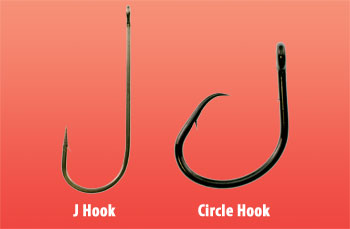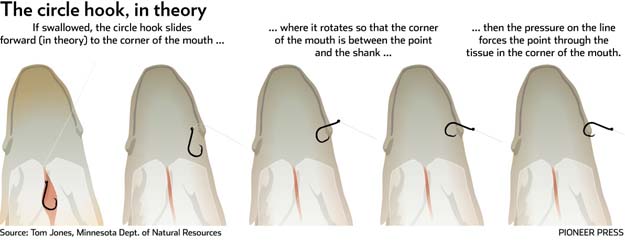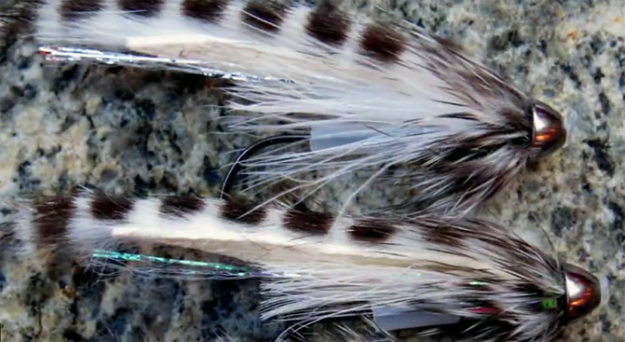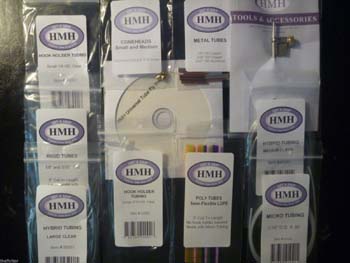About hooks and fish mortality

Image from Florida Sea Grant | University of Florida, Institute of Food and Agricultural Sciences – 2017.
[dropcap]A[/dropcap] study done by biologists from the Idaho Dept. Fish & Game was presented at a symposium in 2014 [Trout mortality of J hooks versus circle hooks]. It concluded that trout mortality from J hooks, versus circle hooks, was significant.
Mortality was measured 69 days post release and fell between 26% and 29% with J hooks (variable baiting and lure) and between 7% and 4% using circle hooks (variable baiting and other).
The hookup percentage was slightly better with J hooks, but J hooks were more prone to being short stuck or thrown. Circle hook catches were not prone to be thrown (or short stuck), and in most cases were in the corner of the trout’s mouth. Thus, the much higher survival rate.
NOTE: Although not a conclusion in the referenced study, extending the fight has a corresponding connection to mortality (exhaustion and predation). Refer to this Bonefish & Tarpon Trust study.
NOTE 2: The circle hooks exhibited in the study were at a 4-degree angle (offset).
NOTE 3: There is no research evidence proving that offset circle hooks or inline circle hooks are better at hook up percentages. IGFA does not accept offset circle hook catches for record purposes.
A look at conventionally hook-tied flies and some of their disadvantages
• Tying a fly on a long shank hook (streamers) creates recognized advantages for a hooked fish. A long shank hook can be better leveraged than a short shank hook. When pressed against an object – a bonefish on a coral outcropping, bass on a log, trout that retreat to rock cover, or simply a lever on head shakes because of the hook’s weight.
• Short strikes are common on hook-tied streamer flies. Many fish “nip” at a fly. Think anadromous spawners and ocean fish in particular. The former reacts out of memory or annoyance as they are not feeding while spawning, and the latter as the way of wounding and then returning to eat the crippled lot.
• That nipping can be somewhat alleviated with an added stinger hook, but in most cases that creates a new problem – launching a brick.
• A fly tied on any hook tends to be visible.
• A dinged point on a chemically sharpened hook is permanently compromised, and the fly is rendered useless. An offshore billfish fly could cost $25. A #20 Adams $4 or personally tied, material cost plus time.
• A fly tied on a large hook does not penetrate as easily as a smaller, thin tapered in-line “circle” hook. Think Gamakatsu Octopus or Owner Mosquito.
• Hook tied flies need to be transported in a fly box, taking up storage space on your person or elsewhere.
 If you can avoid tying a fly on big, heavy hooks, you will be moving towards eliminating short strikes, casting heavy flies, and catching less. Now, think tube flies
If you can avoid tying a fly on big, heavy hooks, you will be moving towards eliminating short strikes, casting heavy flies, and catching less. Now, think tube flies
• The number one advantage of tube flies is reason enough to adopt them: they are much, much easier to cast.
• Tube flies can be rigged with smaller hooks than a counterpart hook-tied fly. In many situations much, much smaller, which will not only aid in casting but increase hook ups.
• Tube flies outlast conventional flies many times over.
• The tube hook can be quickly and manually repositioned to fish up or down.
• Tube flies are much easier to store – keep at the ready. There’s no hook to catch on anything. Hooks can be kept in their packets with sizes and styles ready for use on a specific outing. Conventional wisdom on that score is that the hooks should have the tippet section already attached – ready to connect to a loop or a tippet ring. Changeouts are much, much quicker with tubes with no loss of the fly itself.
• A smaller circle hook can be used on larger tube flies intended for bigger game fish, which will increase hookups. Instead of an 8/0 on a conventionally tied fly, a 4/0 might do the same job on a tube fly.
• Now, smaller tube flies can also utilize circle hooks as they are available down to size #6.
• With a tube fly, a bent hook or a damaged point doesn’t mean you lose a fly; just the hook – put on a new one.
• A tube fly is inherently designed to break away or ride up the leader when a fish is on. The advantage there is the fly doesn’t get mauled – lives for another day. And the fish can’t use the weight of the fly as leverage on a head shake.
• You can stick a dozen or more tube flies in one pocket and a half dozen hooks with attached tippets in another pocket in individual sandwich-size Zip-Lok bags, and you’re good.
NOTE 4: Inline circle hooks are size, feature, and shape limited. Currently only available as small as #6, straight eye and barbed.
Tube tyer notes
You don’t need a special vise to hold the tube in place. Just buy an adapter. There are two types. One is a pin; the other has a flat flared piece attached to a pin. Both anchor on common vises. A vise that rotates and made for tube pins has advantages but is not at all necessary.
The one thing that happens when you begin tying is that the tube rotates and thread can’t be anchored. The tube has to be coaxed into a hold down on one system and clamped. On the other, the tube has to be jammed into the pin where it flares to be thicker.
You can use all kinds of hooks when tying tube flies: long shank, short shank, up eye, down eye, nymph, bait, and circle

Ruben Martin’s Minnow tube fly pattern, tied by Martin Joergensen on YouTube. Materials: Pro Tube bullet body, Pro Tube Flexi Tube transparent, Pro Tube bullet dody, white marabu, Polar Flash Pearl / silver, Rabbit Strip white / black, grizzly hackle and Pro Tube Cone Head black with stick on silver eyes. Image YouTube.
Modern day tube flies were green-lighted in Europe a long time ago. The Brits launched the parade in the 1940’s, but the Scandinavians are leading the way using them for any species, any water. In the Pacific Northwest, it’s been the British Columbians taking up the tube banner. At first, using them exclusively for steelhead, then salmon and now the smaller Oncorhynchus mykiss. Beyond use outside of steelhead and salmon, only small pockets of believers exist in the American Northwest as to the merits of tubes. Eastward to the Great Lakes Region, tubes meet isolated and geographic limits.
Where tube flies would out shine any hook tied fly, they are ignored; completely
Where would that be? Think saltwater: stripers, blues, albies, tarpon, snook, redfish, cobia, sharks, macks, kings, jacks, and anything that lives in the brine.
Many offshore sports bill fishers have gone to tubes, but their sport is so people limited due to the entry fee that it’s only spokes-publications, Marlin magazine and The Billfish Foundation’s magazine title entries (Billfish, Spearfish, Sailfish) would be the only places where you’d find tubes mentioned.
FAQ:
What about largemouth bass, smallmouth bass, musky, carp, catfish, walleye, and panfish? Tube flies are go-to for those that prefer catching to fishing. There isn’t a “fish species wall” on tube flies, and none in the question qualifies.
Is getting into tube flies expensive? No, on a scratch basis, it would be about the same as getting into hook tied files, but most say it’s cheaper. Adding an adaptor to an existing vise is less than $15, and few tubes are all it takes to be in the tube fly business.
Is it more difficult to tie a tube fly than a hook tied fly? I can’t think of a fly that would be more difficult to tie on a tube. All tube patterns utilize the same techniques as required on a conventionally tied hook.
Are there savings like buying Q-tips for tubes? Yes, but they have serious short comings like cracking, collapsing, and splitting apart when cold and bounced off a rock or hard surface. I’ve long ago gone to the belief that you get what you pay for. Stick with the industry suppliers, and don’t ever bite on cheap hooks – huge mistake.

HMH provides a complete tube fly tying starter kit. Everything that is available in tube tying (from HMH) is in the kit, There’s a video, and the adaptor tool and pins for your standard jawed vise. You do not need anything else – just start tying. Tying is “exactly” the same as you’re used to.
Are circle hooks an advantage? Yes, in every way possible, better hold post hook up, less mortality on released fish, and easy hook removal because 99% of the time it will be in the corner of the fish’s mouth. On the catch side they are about the same as conventional hooks (hook sizes being equal) but using smaller hooks on larger tube flies does catch more fish, a lot more.
Is casting a tube fly more difficult than casting a similar hook tied pattern? No. Casting a tube fly is much, much easier than casting its heftier hook tied twin. Why? Because it will be significantly lighter, especially with articulated patterns, big streamers, and bass – tarpon like patterns. Think weight of the hook.
Are there a lot of videos on tying tube flies? Sorry, there isn’t a library of tube fly Vimeo’s or YouTube videos available. Even the best video tying producers, Inthriffle, Tim Flager and Jay Nichols are all but silent on the matter of tube flies. Almost all the tube fly vids are limited to steelhead flies or salmon flies. Nichols’ Caddis Fly Shop does a much better job.
Here are the top suppliers of tube tying essentials:
NOTE 5: The following two articles appeared in Fly Fisherman in 2014. They both delve deeply into the minutiae of tubes.
April Vokey’s Stacker Tube Evolution
Tom Rosenbauer on Saltwater Tubes
The “Canadian” video introduces the basics of tube fly tying. The Eumer video shows just how easy it is to tie a Clouser Minnow pattern to a tube and rig a hook.


